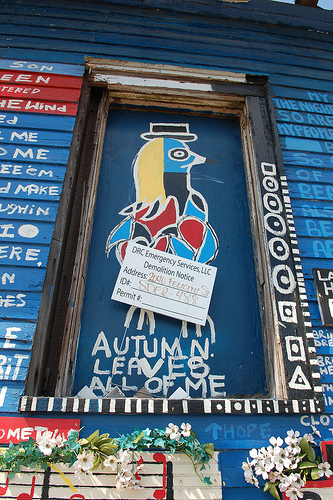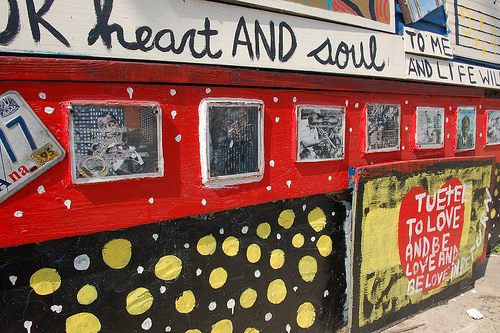By Karen Gadbois, The Lens staff opinion writer |
There’s a familiar ring to it: yet another house being knocked down as preservationists scramble in vain to defend it. But don’t be deceived. This time it’s not about the house.
No one pretends that the blighted Central City double at 2040 Felicity Street was an architectural masterwork or even salvageable as a residence. That didn’t stop neighbors from prying souvenir weatherboards off the street front façade as bulldozers rumbled into action on Wednesday.
By all accounts, the blighted building was beyond repair. A fire, neglect and termites had all had their way with it. But for traveling artist Henry Hechavarria it was the perfect canvas on which to celebrate the city’s musical and cultural history.
Hechavarria, 27, a Cuban-American of African heritage came to town a year ago under the auspices of The United Saints, a Central City disaster recovery non profit. His toolkit consisted of nothing more than paint, brushes and a vision.
The vision was partly esthetic. He painted the place a startling shade of sky-blue. It was also verbal. Fragments of the epic “Heritage,” by Harlem Renaissance poet Countee Cullen, were included in the façade.
All day long and all night through
One thing only must I do:
Quench my pride and cool my blood,
Lest I perish in the flood.
Musical scores and song titles by Louis Armstrong and Notorious B.I.G. co-existed with the words of Langston Hughes.
Pages of an old magazine with photos of important figures in African-American cultural history were glued to the house with bits of mirrors and plastic flowers.
The house straddled the line between a sophisticated Rauschenberg assemblage and a funky take on folk art, spiced with a dash of graffiti.
One measure of Hechavarria’s success was that no other markings besmirched his work, no rival artiste had come forward, spray can in hand, to disrespect him.
A tiresome symptom of blight had been transformed into a billboard advertising a neighborhood’s pride and resilience.
Belatedly, as it turned out, an effort was mounted to save the mural. Messages were left with city officials asking that the demolition be delayed at least until the façade could be dismantled by curators with the Presbytere’s exhibit, “Katrina and beyond.”
City blight czar Jeff Hebert says he never got them. It was another instance of too little too late. Why had preservationists waited until the last minute to raise their clamor? The house had been on demolition lists since way back last August, according to mayoral spokesman Ryan Berni.
The same lack of coordination, followed by a spasmodic stab at preservation, preceded last week’s demolition du jour: the destruction of the row of shotguns in the 2700 block of S. Derbigny Street that figure as cover art for the boxed set of DVDs comprising Season One of HBO’s “Treme” series.
Both demolitions raise the interesting question of whether preservationism – even in this thoroughly preservation-conscious city — needs to rethink its game plan. An earlier start on campaigns to save threatened buildings is only the most obvious need. Equally important is the need to augment the preservationist playbook.
There’s more to New Orleans than priceless architecture. The city seemed to realize that when we lined up for hours to patronize a re-opened Brocato’s ice cream parlor. The same devotion was lavished on Dooky Chase’s restaurant and on Willie Mae’s Scotch House, two soulful eateries within blocks of each other as they came back to life.
The city – assisted by Habitat for Humanity, among others — understood the dire threat, indeed, the risk of cultural annihilation implicit in a recovery strategy that did not make special provision for getting our musicians to come back and live here. The result, for all its troubles with Chinese drywall, was Musician’s Village.
“If we don’t pay attention to preserving the city’s organic cultural heritage, we jeopardize both our economy and our identity,” notes Catherine Barrier, an adjunct professor of architecture at Tulane University.
Hechavarria’s Felicity Street façade was a part of the visual city – as opposed to the culinary or musical or residential tout ensemble. Its demolition raises questions about the memory of the Katrina disaster and the proper way in which to memorialize it.
The State Museum’s Katrina exhibit is a step in the right direction, and so are the historical plaques excoriating the Army Corps that Levees.org has erected at places where the city’s flood defense failed so catastrophically.
Before the wrecking crew erased the Felicity Street structure this week, the mural was documented by the State Museum’s chief photographer Mark Sindler, who has been collecting signs and other visual icons of Katrina ever since the disaster. He had hoped to preserve the façade as a museum exhibit – better than nothing but hardly the same as simply leaving the façade where it stood.
Some homeowners in stride with this spirit have preserved the iconic bull’s-eyes that search-and-rescue teams sprayed on their homes. Journalist Chris Rose made one of them famous as the title of his collection of Katrina columns, “One Dead in Attic.”
Hechavarria had no illusions that he was creating a monument that would last to the end of time. It was inevitable that it would be knocked down, he said Thursday as word of the demolition reached him at his home in New Jersey.
But the city’s act of cultural vandalism, if inevitable, also carried symbolic value for Hechavarria. “The house being destroyed is a representation of where African people are in the 21st Century,” he said dryly – “ridiculed, attacked, oppressed and destroyed. “
Hechavarria’s colorful facade had given one neighborhood a focus for meditation on community and loss. Now, in the gap where his work stood, we can continue the meditation, the part of it that is about loss.



